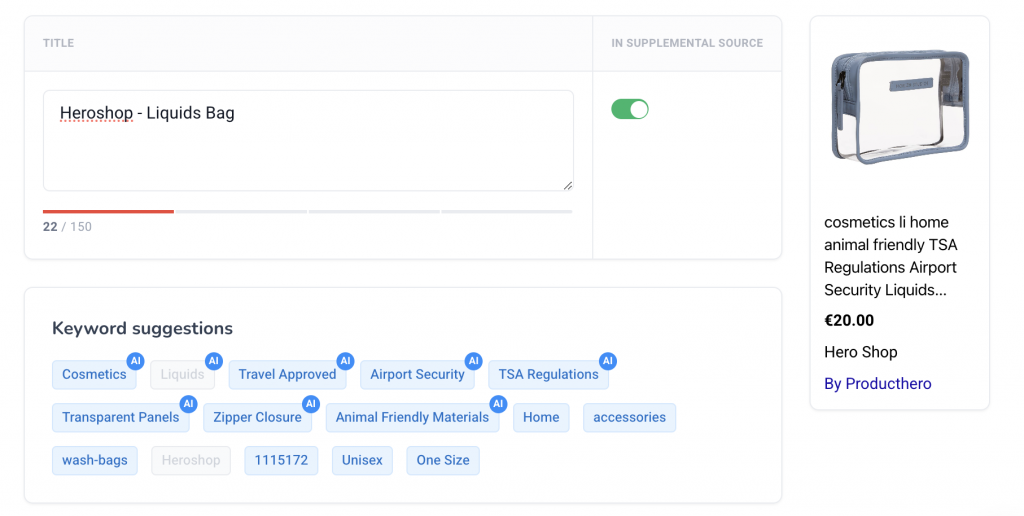Last updated on February 05, 2025
10 sources for product title keyword research for Google’s shopping ads
In this article, we’ll walk you through tools and sources that can help optimize your product titles for Google Shopping Ads. A key factor for product ranking in Google Shopping is RELEVANCE. The more relevant your titles are, the more impressions, clicks, and conversions you’ll drive. Relevance is all about ensuring Google can effectively match your product to the search terms potential buyers are using.
The most effective way to improve your relevance is by optimizing your product titles. Make sure to read our article on best practices for title optimization. To stand out, you need to understand what people are searching for, and by using the language of your customers in your product titles, you increase the chances of your ads showing up for the right search terms.
The Producthero Title Optimizer is the ideal tool for optimizing and enriching your product titles. It allows you to add new, relevant terms that weren’t in your original product description. The tool is data-driven, giving you suggestions based on AI and based on attributes from your product feeds that don’t rely on AI-generated suggestions.

If you want to go further, you can always manually add keywords to your title. Below, we’ve listed 10 research sources you can use to take your title optimization to the next level.
10 research sources for shopping titles
1. Your Shopping Ads search term data
In your Google Ads account, select the campaign you’re interested in. Then, go to the “Keywords” tab and check the exact search queries that triggered your ads, along with performance data like clicks, impressions, and conversions.
2. Your text ad campaign search term data
Analyze the search term reports of the text ad campaigns in your Google Ads accounts. What are words in high converting search terms that you do not use in your Product titles yet? Add them to your titles!
3. Your product content
Analyze the product page and images. What are important words or characteristics that describe the product and are not yet in the product title?
4. Product attributes
Look at the product attributes. I many cases they are already in your feed, but sometimes not in the title. Think of color, gender, material, brand, etc.
5. Google Trends
Are you using and focusing on the words most of your customers are actually using? With Google Trends you can compare analyze the search volume on generic words that describe the product.
6. Google Suggest Data
One of the easiest way to get an impression of your customers’ language is just type in some words in google and see what Google suggests:
7. Google Keyword Planner
8. Your competitors
Search for your products in the Google and the Google Shopping tab. What product titles do your competitors use? Analyze their product pages. Discover words and characteristics your competitors use that you can add to your titles.
9. SEO Tools
Keyword research is not new. It has been done by SEO’s for years. And there are great free and paid tools that can help you. Think of Ubersuggest, Moz, SEMrush, KWFinder.
10. Common sense
Last but not least… What would you search for when you were looking for a specific product? 🙂 Do you see important words and characteristics that are not in the title yet?
Conclusion: optimizing your titles can double your impressions
Optimizing your product titles is a simple yet very effective way to increase the volume of your shopping campaigns without raising your bids. In this article, we’ve shared a few sources you can use to research and improve your titles. Some of our customers have even doubled their impressions just by optimizing their shopping ad titles. Check out how Wehkamp boosted their product impressions.
You can combine these insights with the suggestions provided by the Producthero Title Optimizer, our tool for enhancing product titles for Shopping Ads. See it in action:
